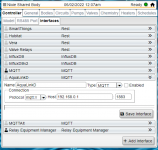Hello,
I am looking at using a RPi to control my pool equipment and a friend recommended this forum. Doing a search, I came across some very impressive setups but the complexities were way over my head with controlling valves and SWGs. Hoping someone can clarify the best approach I should take based on my setup. My goal is fairly simple - basically remotely control my variable speed pump and heater.
Current setup:
1. Jandy variable speed pump controlled by a Jandy JEP-R digital controller.
- Looking at the manual, there's a remote control connector.
"The controller allows speeds "1" through "4" to operate via remote contact closures (switch or relay)." This seems simple but I couldn't find any information on anyone using it.
2. Pentair tempmaster 200 heater
- Guessing I would need a usb RS485 adapter and interface with the RS485 port?
I don't have any type of pool controller ie. intellicenter etc currently. It's all manual control on the heater itself or the JEP-R controller.
What would be the best approach I should take?
Thanks in advance
I am looking at using a RPi to control my pool equipment and a friend recommended this forum. Doing a search, I came across some very impressive setups but the complexities were way over my head with controlling valves and SWGs. Hoping someone can clarify the best approach I should take based on my setup. My goal is fairly simple - basically remotely control my variable speed pump and heater.
Current setup:
1. Jandy variable speed pump controlled by a Jandy JEP-R digital controller.
- Looking at the manual, there's a remote control connector.
"The controller allows speeds "1" through "4" to operate via remote contact closures (switch or relay)." This seems simple but I couldn't find any information on anyone using it.
2. Pentair tempmaster 200 heater
- Guessing I would need a usb RS485 adapter and interface with the RS485 port?
I don't have any type of pool controller ie. intellicenter etc currently. It's all manual control on the heater itself or the JEP-R controller.
What would be the best approach I should take?
Thanks in advance


